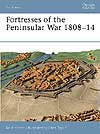Book
Review:
Fortresses of the Peninsular War, 1808 to 1814
By
Ian Fletcher
Artwork by Chris Taylor
 Some
of the most amazing tales to come out of the Peninsular War are
associated with the fortresses, the sieges that weakened them
and the bloody assaults that finally captured them.
Some
of the most amazing tales to come out of the Peninsular War are
associated with the fortresses, the sieges that weakened them
and the bloody assaults that finally captured them.
The
horrendous explosion that destroyed Almeida, the costly taking
of Ciudad Rodrigo, the British failure at Burgos, San Sebastian
and, of course, the most awful storm of all - that of Badajoz.
In
Fortresses of the Peninsular War 1808 to 1814, Ian Fletcher
examines the main fortresses of Spain and Portugal and details
their strategic importance and how they fared against besiegers.
The
book focuses on Ciudad Rodrigo, Badajoz, Burgos and San Sebastian
and how the operations against them were vital in deciding the
outcome of the war.
Fletcher
sets the scene with a two-page introduction and then devotes six
pages to The Evolution of the Fortress by the time of the Napoleonic
Wars.
Then
it's on to Ciudad Rodrigo, Burgos, Badajoz and San Sebastian for
a brief tour in which Fletcher explains how they were positioned,
their strengths and weaknesses.
Some
of the best information in Fortresses of the Peninsular War
1808 to 1814 is dedicated to The Principles of Defence and
The Besieger and the Besieged where Fletcher looks at life inside
and outside the walls. He also compares the performances of the
commanders of Badajoz (General Phillipon), Burgos (General Dubreton),
Ciudad Rodrigo (General Barrie) and San Sebastian (General Rey)
and gives detailed descriptions of the attacks on their garrisons.
Chris
Taylor's illustrations of each fortress are nothing short of excellent.
They include 3D representations of the overall site and cross-sections
showing the various types of defensive lines that the engineers
created to make attacking the bastions so terrifyingly difficult.
These
are added to by a good glossary and an illustration to show you
the difference between a parapet, ravelin and glacis to name a
few.
And
special mention has to be made of the photographs and images used
in the book. They include black-and-white drawings of the assaults
on the major fortresses, there are coloured contemporary pictures
of the towns and modern colour photogrpahs. All help bring the
subject to life.
Peninsular
War fans should have this volume in their collections.
Now
I have a point to make to Osprey about it's back cover blurb.
On it there is the comment: "Indeed, the performance of his
(Wellington's) army during the sieges was probably the most disappointing
aspect of what was an extremely successful campaign."
I
don't know about anyone else, but I regard that as rubbish. Despite
being badly equipped and asked to attack fortresses and witness
some of the most awful carnage ever seen - the British army succeeded.
The soldiers were superb and courageous. If the blurb writer is
complaining about their antics in Ciudad Rodrigo and Badajoz following
their capture then all I can say is - grow up. It was - and is
- part of warfare.
-
Richard Moore
8.5/10
Osprey
Website
Osprey
PO Box 140,
Wellingborough,
Northants,
NN8 2FA,
UK.